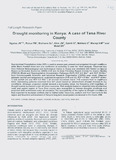Drought monitoring in Kenya: A case of Tana River County

View/
Date
2014-07Author
Ngaina, J N
Mutua, F M
Muthama, N J
Kirui, J W
Sabiiti, G
Mukhala, E
Maingi, N W
Mutai, B K
Language
enMetadata
Show full item recordAbstract
Standardized Precipitation Index (SPI) is used to assess past, present and projected drought conditions
while Mann Kendall trend test and coefficient of variability is used for trend analysis. Observed data
from National Meteorological and Hydrological Centre in Kenya and simulated data based on Special
Report on Emission Scenarios (SRES) A18 and A2 from Providing Region Climate for Impact Studies
(PRECIS) Model and Representative Concentration Pathways (RCP) RCP 4.5 Wm·2 and RCP 6,0 Wm·2
from Commonwealth Scientific and Industrial Research Organization (CSIRO) were used, Observed
datasets (rainfall and temperature), projected temperature (A18 and A2, RCP 4.5 Wm"2 and RCP 6.0Wm"
2) and rainfall (A2 and RCP 6.0 Wm"2) all showed monotonic trend. A18 scenario had no significant
trend. Decreasing patterns observed from SPI values based on observations showed increase in dry
conditions. Although projected rainfall showed a decreasing trend, the frequency and magnitude of
drought events increased under all future scenarios. Risk analysis based on observed data showed that
north and central region of Tana River county were susceptible to intense droughts conditions and
projected shift northwards under all scenarios. The susceptibility of the region to drought conditions is
thus expected to increase conflicts due to limited water resources, pasture and food insecurity in the
region and thus limit achievement of Kenya's long term development envisioned in the Vision 2030.
